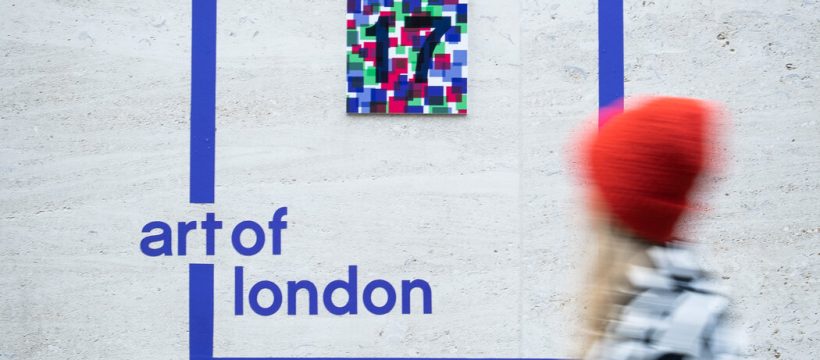LONDON — Major art museums in London are using augmented reality as a way to share works with the public and to entice visitors back inside, even with coronavirus restrictions in flux.
The National Gallery has teamed up with the National Portrait Gallery, the Royal Academy of Arts and other organizations to create the Augmented Gallery, an app-accessible interactive walking trail of 20 historic and contemporary pieces visible by smartphone.
These three museums, along with the British Museum and the Tate, are among those that are open — admitting a reduced number of visitors, who must reserve tickets ahead to allow for social distancing.
The outdoor gallery route stretches across the center of the city, from west of Piccadilly Circus to east of Leicester Square, starting at the National Gallery and ending outside the Royal Academy.
By downloading the free app (search for “Art of London AR Gallery” in your preferred app store) and scanning QR codes attached to exterior walls along the way, walkers can see and hear details about older oil paintings like Anthony van Dyck’s “Equestrian Portrait of Charles I” and Vincent van Gogh’s “Sunflowers,” or more contemporary pieces like Tracey Emin’s acrylic work “Trying to Find You 1.” Also included are works by winners and finalists in the Sky Portrait Artist of the Year competition that capture personalities like the American musician Nile Rodgers by Christabel Blackburn or the English actress Elaine Paige by Toby Michael.
One recent afternoon on St. Martin’s Lane outside the building that houses the English National Opera, Veronica Marcano was pointing her smartphone at a multi-colored-patterned plaque on a wall, learning more about the so-called “Chandos portrait” of Shakespeare, possibly painted from life in the early 1600s by an artist named John Taylor. (The National Portrait Gallery says this is the first portrait it acquired, back in 1856.)
Downloading the app and then scanning the codes was no hurdle for Ms. Marcano, who had long worked in the software sector in London but was “taking a sabbatical from work to do painting,” she said.
“I’d walked around here and seen these squares in a number of places,” she said. “And today I went, ‘OK, I’ve got to find out what this is because it looks interesting.’ So I downloaded the app and I’m loving it.”
Other portraits on the trail are of more contemporary figures such as the singer Tom Jones by Duncan Shoosmith and the Nobel Peace Prize-winning activist Malala Yousafzai by Shirin Neshat.
The British actor Stephen Mangan, who can be heard on the app discussing the Jones portrait, said in a news release that the Augmented Gallery was “such a great initiative that people can enjoy safely outdoors in the heart of London’s West End, and I hope it introduces these timeless classics and contemporary masterpieces to new audiences.”
Another celebrity narrator is the British comedian James Acaster, who weighs in on the van Dyck, for one.
The Augmented Gallery is part of a wider initiative to reposition London’s West End as an arts and culture destination; the normally bustling zone was eerily quiet during the darkest days of the pandemic in the city. One hope is that people will come to see the art, then stay for a meal or a show.
Another project with similar goals is “Scenes in the Square,” a movie-themed sculpture trail in and around Leicester Square, where many of the big British cinema premieres take place.
The “scenes” — accompanied by a free audio tour available on Spotify — consist of nine steel, fiberglass and bronze statues of figures from film and television dotted around on buildings, on benches and in flower beds.
Among them are Mary Poppins raising her open umbrella; Harry Potter riding his Quidditch broom; an eerily realistic Mr. Bean; a marmalade sandwich-munching Paddington Bear; a muscular Batman looking down from the roof of a movie theater; and a lasso-wielding Wonder Woman on the side of another building.
Introduced last year, the installation is scheduled to expand this summer, when a 10th sculpture is to be added — an empty Iron Throne from the HBO series “Game of Thrones,” suitable for selfies.
Yet another way to engage in London’s outdoor art scene is by checking out what’s on top of a pedestal known as the Fourth Plinth, in Trafalgar Square. You can even help decide what goes up there next, if you hurry.
Every few years, the public can vote for finalists for the public art commission.
The current work is “The End” by the British artist Heather Phillipson. Her sculpture looks like a giant dollop of whipped cream topped with a cherry, a fly and a drone that films passers-by and displays them in real time on the web. For the first time, the plinth includes a plaque explaining it all in Braille.
Previous works have included an oversize ship in a bottle by the British-Nigerian artist Yinka Shonibare, in what was seen as a commentary on colonialism, and a giant blue rooster by the German sculptor Katharina Fritsch that has been interpreted as a comment on masculine posturing.
Now artists from Britain, Germany, Ghana, Mexico and the United States are competing to get their work on the plinth in 2022 or 2024 with themes including defiance, racism, sexuality and ecology. The winners will be decided by the Fourth Plinth Commissioning Group, made up of artists, curators and journalists, taking the public vote into account.
Models of their proposed works are on free display at the National Gallery until July 4. You can vote for your favorite online, but be speedy — voting closes on Sunday.
Source: Read Full Article

